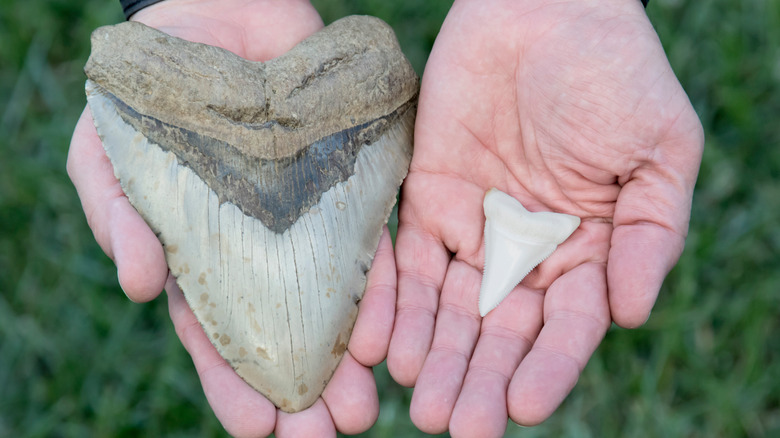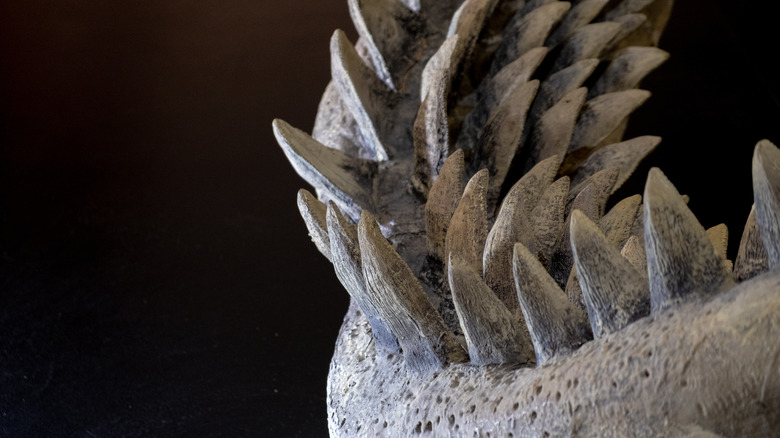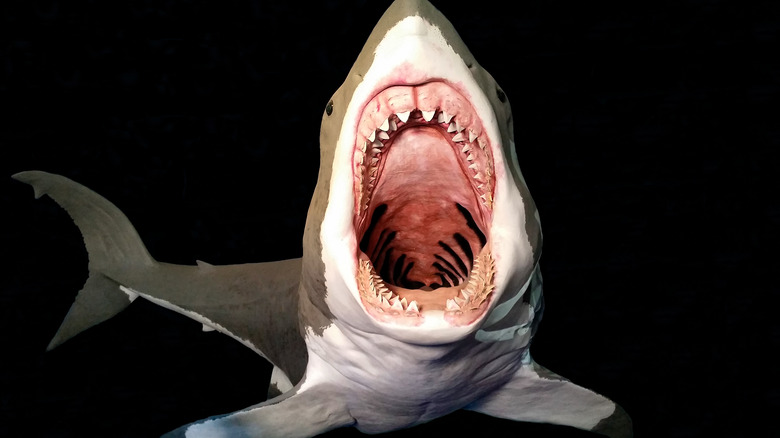The Brutal Way The Megalodon Disabled Its Prey
Megalodon, also called by its scientific name Carcharocles megalodon, was a fearsome prehistoric predator that cruised the Miocene seas over 15 million years ago. Megalodon has been the subject of plenty of pop culture attention for its enormous size, with the largest ones maxing out at 60 feet in length and up to 50 tons. Smithsonian's Ocean website compares them to "the size and weight of a railroad car." This makes the megalodon the biggest shark ever to have lived, which is surprising in light of new research that indicates the giant shark is the ancestor of the modestly sized mako shark, rather than the great white, as previously thought (via Smithsonian Ocean).
Much of the information known about the megalodon shark's anatomy comes from reconstructions of teeth that have been discovered. By comparing the proportions to modern sharks, scientists have estimated the megalodon's features and behavior (via Smithsonian Ocean). Given their size, it's been understood for a while that megalodon must have feasted on something large enough to sate its appetite: whales. This year, a paleontological discovery shed light on the hunting behavior of this brutal marine predator (via Live Science).
Who was megalodon?
Megalodon likely lived during the Miocene (23 million to 2.6 million years ago), becoming extinct during the succeeding Pliocene epoch. The mysterious beast left behind teeth of up to seven inches in length, but with a skeleton made of cartilage, like modern sharks, inference has abounded since its discovery in 1835. Back then, scientists looked at the pattern of serrations on the teeth and compared it to that of present-day white sharks, which seemed like a positive match. More studies indicated that white sharks evolved from another lineage and that the serration pattern could have been the result of convergent evolution, a process in which similar traits can evolve separately without a direct genetic relationship (via Britannica).
Despite the murkiness of its evolution, it's known that megalodon was an opportunistic predator who ate a wide variety of marine animal life, including seals, sea turtles, fish, and, of course, whales. Evidence has come from studies done on whale bones that had megalodon shark teeth embedded in the bone, along with striations from the serrated teeth (via Smithsonian Ocean). The newest find in this vein may offer more insight into the magnitude of their ferocity.
A whale of a discovery
Mike Ellwood, a volunteer at the Calvert Marine Museum, was out fossil hunting in the Calvert Cliffs of Maryland when he came across a 15-million-year-old whale vertebrae. Stephen J. Godfrey, a paleontologist at the museum, was instantly intrigued by the apparent trauma to the bone. At the scene of the fractured vertebrae was also a megalodon tooth. Godfrey said (via Live Science), "We only have circumstantial evidence, but it's damning circumstantial evidence." CT scans showed that the whale suffered a compression fracture and the formation of new bone tissue indicated that it survived for weeks after what appeared to have been an attack, according to Live Science.
The scenario proposed by Godfrey was that the shark attacked the whale from below and sank its saw-like teeth into the victim's mid-section. Once a struggle ensued between the shark and the 13-foot whale, the force of the jaws and the violent thrashing caused the whale to bend back, thus fracturing its vertebrae. In his paper for Palaeontologia Electronica he proposed other explanations for the injury and tooth, including seizures and scavenging by sharks after its death. However, Godfrey maintains that an altercation between the prehistoric creatures better fits the evidence (per Newsweek).


